-
Countries
-
Data and Analysis
-
Special Focus
-
Crisis Responses

Contact
DTM Europe, DTMMediterranean@iom.int
Language
Bosnian, Croatian, Serbian
Location
Bosnia & Herzegovina
Snapshot Date
Mar 24 2022
Activity
- Migrants presence
- Mobility Tracking
24.3.2022, provedena je jedanaesta zajednička vježba od strane IOM-a u Bosni i Hercegovini (BiH), u saradnji sa Službom za poslove sa strancima (SPS), uz podršku Crvenog križa BiH (CKBiH) kako bi prikupili informacije o broju migranata i tražioca azila koji se trenutno nalaze u državi. Svrha ove redovne vježbe je da se pruži okvirni broj migrantske populacije koja nije smještena niti registrovana ni u jednom od Privremenih prihvatnih centara (PPC) u datom trenutku.
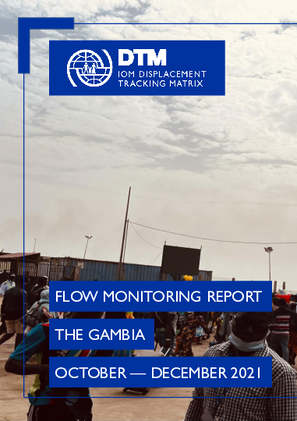
Contact
RO Dakar, RODakar-DataResearch@iom.int
Language
English
Location
The Gambia
Period Covered
Oct 01 2021
Dec 31 2021
Activity
- Survey
- Flow Monitoring Survey
- Flow Monitoring
In order to gain a better understanding of mobility flows and trends throughout West and Central Africa, the International Organization for Migration (IOM) implements the Displacement Tracking Matrix’s Flow Monitoring (FM) tool at key transit points across the region.
In The Gambia, DTM conducts Flow Monitoring activities at several important transit locations: in 1) Barra (FMPs are located at the ferry terminal and the main garage);
2) Farafenni (FMPs are located at Farafenni main garage, Farafenni Ballan-Ghar garage, Farafenni McCarthy and Sanjally garage, Farafenni turntable garage and the truck garage); 3) Basse (FMPs are situated at the main garage and the bus station in Basse Santa-Su) and 4) Brikama (FMPs are located at the main garage and the Bus station).
This activities enable DTM to monitor the movements of passenger within The Gambia, out of and towards The Gambia as well as transiting The Gambia.
This report presents the key results from the Flow Monitoring Survey conducted with travellers between October and December 2021. The report presents data collected on flows, routes, provenance, destination and demographic profiles of travellers observed at the FMPs.

Contact
DTM Europe, DTMMediterranean@iom.int
Language
English
Location
Bosnia & Herzegovina
Snapshot Date
Mar 24 2022
Activity
- Migrants presence
- Mobility Tracking
On 24 March 2022, the eleventh joint data collection exercise was conducted by IOM Bosnia and Herzegovina (BiH), together with the Service for Foreigners’ Affairs (SFA), and the support of the Red Cross Society BIH (RCSBH) to collect information on the number of migrants and asylum-seekers present in the country. The purpose of the exercise was to provide an estimation of the migrant population (stock) that was not accommodated or registered in any official Temporary Reception Centres (TRCs) at any g iven date. Fourteen teams were deployed for a total of 39 enumerators (27 males and 12 females), plus 11 SFA staff (8 males and 3 females), 13 RCSBH staff (8 males and 5 females).
The data collection exercise was implemented in 7 Cantons of the Federation of Bosnia and Herzegovina (FBiH) and in 5 regions in the Republika Srpska (RS) entity. A total of 233 locations3 in 49 different municipalities were visited: 74 locations in 5 municipalities in Una-Sana Canton, 44 locations in 6 municipalities in Sarajevo Canton, 35 locations in 10 municipalities in Tuzla Canton, 20 locations in 5 municipalities in Herzegovina – Neretva Canton, 4 locations in 4 municipalities in West Herzegovina
Canton, 3 locations in 1 municipality in Bosnian Podrinje Goražde Canton, 2 locations in 2 municipalities in Canton 10, 11 locations in Zvornik, 7 locations in Višegrad, 5 locations each in Vlasenica and Bijeljina, 4 locations in Kozarska Dubica, 3 locations each in Foča and Rudo, 2 locations each in Banja Luka, Gradiška, Rogatica, Srbac, and 1 location each in Milići, Kostajnica, Prijedor, Bratunac and Novi Grad.
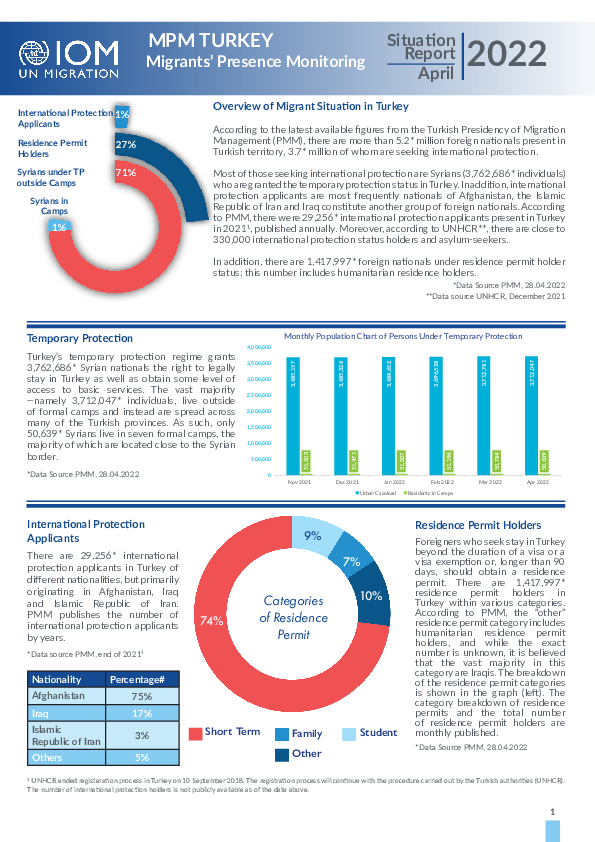
Contact
DTM Turkey, dtmturkey@iom.int
Language
English
Location
Republic of Türkiye
Period Covered
Apr 01 2022
Apr 30 2022
Activity
- Flow Monitoring
- Migrants presence
- Mobility Tracking
According to the latest available figures from the Turkish Presidency of Migration Management (PMM), there are more than 5.2* million foreign nationals present in Turkish territory, 3.7* million of whom are seeking international protection.
Most of those seeking international protection are Syrians (3,762,686* individuals) who are granted the temporary protection status in Turkey. In addition, international protection applicants are most frequently nationals of Afghanistan, the Islamic Republic of Iran and Iraq constitute another group of foreign nationals. According to PMM, there were 29,256* international protection applicants present in Turkey in 20211, published annually. Moreover, according to UNHCR**, there are close to 330,000 international protection status holders and asylum-seekers. In addition, there are 1,417,997* foreign nationals under residence permit holder status; this number includes humanitarian residence holders.
*Data Source PMM, 28.04.2022
**Data source UNHCR, December 2021
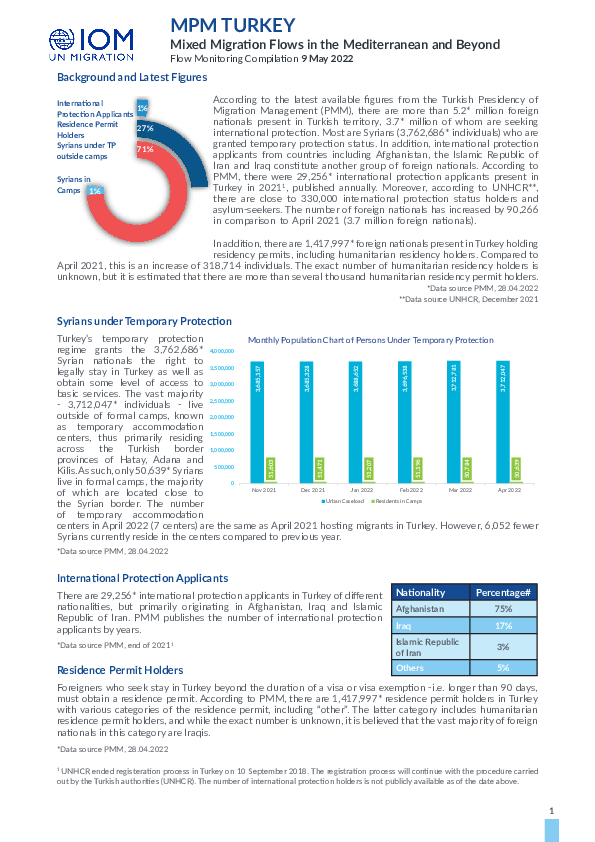
Contact
DTM Turkey, dtmturkey@iom.int
Language
English
Location
Republic of Türkiye
Period Covered
Apr 01 2022
Apr 30 2022
Activity
- Flow Monitoring
- Migrants presence
- Mobility Tracking
According to the latest available figures from the Turkish Presidency of Migration Management (PMM), there are more than 5.2* million foreign nationals present in Turkish territory, 3.7* million of whom are seeking international protection. Most are Syrians (3,762,686* individuals) who are granted temporary protection status. In addition, international protection applicants from countries including Afghanistan, the Islamic Republic of Iran and Iraq constitute another group of foreign nationals. According to
PMM, there were 29,256* international protection applicants present in Turkey in 20211, published annually. Moreover, according to UNHCR**, there are close to 330,000 international protection status holders and asylum-seekers. The number of foreign nationals has increased by 90,266 in comparison to April 2021 (3.7 million foreign nationals).
In addition, there are 1,417,997* foreign nationals present in Turkey holding residency permits, including humanitarian residency holders. Compared to April 2021, this is an increase of 318,714 individuals. The exact number of humanitarian residency holders is unknown, but it is estimated that there are more than several thousand humanitarian residency permit holders.
*Data source PMM, 28.04.2022
**Data source UNHCR, December 2021
Contact
DTM Yemen, iomyemendtm@iom.int
Location
Yemen
Activity
- Mobility Tracking
- Event Tracking
Period Covered
May 01 2022 -May 07 2022
IOM Yemen DTM’s Rapid Displacement Tracking (RDT) tool collects data on estimated numbers of households forced to flee on a daily basis from their locations of origin or displacement, allowing for regular reporting of new displacements in terms of estimated numbers, geography, and needs. It also tracks returnees who returned to their location of origin.
From 1 January to 7 May 2022, IOM Yemen DTM tracked 5,640 households (HH) (33,840 Individuals) who experienced displacement at least once.
Between 1 and 7 May 2022, IOM Yemen DTM tracked 34 households (204 individuals) displaced at least once. The majority of people moved into/within the following governorates and districts:
Between 1 and 7 May 2022, IOM Yemen DTM tracked 34 households (204 individuals) displaced at least once. The majority of people moved into/within the following governorates and districts:
- Ad Dali (16 HHs) – Ad Dali (11 HHs), Qatabah (5 HHs) districts. Most displacements in the governorate originated from Taiz and Ad Dali.
- Marib (10 HHs) – Marib City (9 HHs), Marib (1 HHs) districts. Most displacements in the governorate originated from Marib and Taiz.
- Shabwah (5 HHs) – Ataq (5 HHs) district. Most displacements in the governorate originated from Ibb and Taiz.
- Taiz (12 HHs) – Mawiyah (6 HHs), Maqbanah (3 HHs), Al Maafer (2 HHs) districts.
- Ad Dali (6 HHs) – Qatabah (4 HHs), Al Husha (2 HHs) districts.
- Ibb (5 HHs) – Al Odayn (5 HHs) district.
Population Groups
Survey Methodology
Unit of Analysis Or Observation
Type of Survey or Assessment
Keywords
Geographical Scope
Administrative boundaries with available data
The current dataset covers the following administrative boundaries
Contact
DTM Yemen, iomyemendtm@iom.int
Location
Yemen
Activity
- Mobility Tracking
- Event Tracking
Period Covered
Apr 24 2022 -Apr 30 2022
From 1 January to 30 April 2022, IOM Yemen DTM tracked 5,606 households (HH) (33,636 Individuals) who experienced displacement at least once.
Between 24 and 30 April 2022, IOM Yemen DTM tracked 40 households (240 individuals) displaced at least once. The majority of people moved into/within the following governorates and districts:
Between 24 and 30 April 2022, IOM Yemen DTM tracked 40 households (240 individuals) displaced at least once. The majority of people moved into/within the following governorates and districts:
- Marib (18 HHs) – Marib City (14 HHs), Marib (4 HHs) districts. Most displacements in the governorate originated from Ibb and Marib.
- Ad Dali (15 HHs) – Ad Dali (9 HHs), Qatabah (6 HHs) districts. Most displacements in the governorate originated from Taiz and Ad Dali.
- Shabwah (6 HHs) – Bayhan (6 HHs) district. Most displacements in the governorate originated from Al Bayda.
- Ibb (12 HHs) – Hobeish (3 HHs), Al Odayn (2 HHs), Al Qafr (2 HHs) districts.
- Taiz (6 HHs) – Al Qahirah (2 HHs), Mawiyah (2 HHs), Sami (1 HHs) districts.
- Al Bayda (6 HHs) – Nati (5 HHs), Radman (1 HHs) districts.
Population Groups
Survey Methodology
Unit of Analysis Or Observation
Type of Survey or Assessment
Keywords
Geographical Scope
Administrative boundaries with available data
The current dataset covers the following administrative boundaries
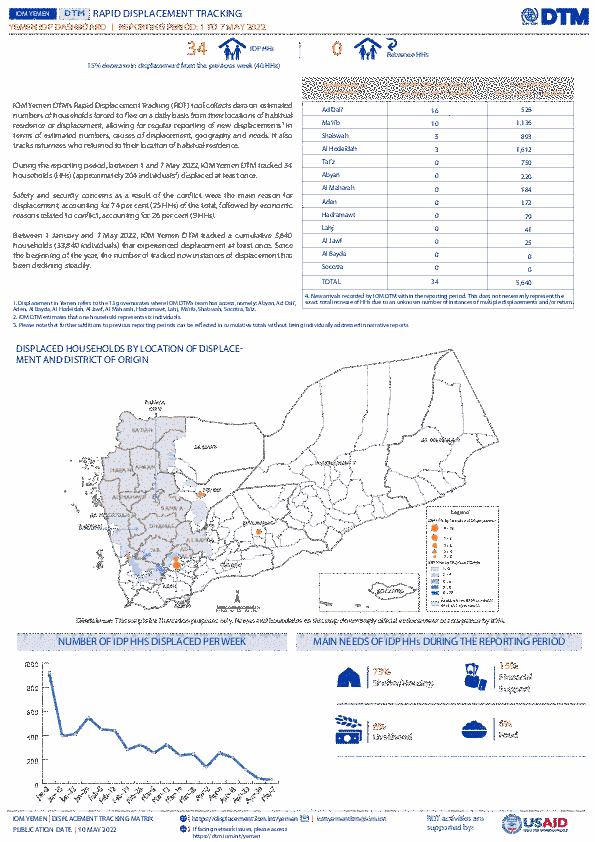
Contact
DTM Yemen, iomyemendtm@iom.int
Language
English
Location
Yemen
Period Covered
May 01 2022
May 07 2022
Activity
- Rapid Emergency Registration
- Mobility Tracking
IOM Yemen DTM’s Rapid Displacement Tracking (RDT) tool collects data on estimated numbers of households forced to flee on a daily basis from their locations of origin or displacement, allowing for regular reporting of new displacements in terms of estimated numbers, geography, and needs. It also tracks returnees who returned to their location of origin.
From 1 January to 7 May 2022, IOM Yemen DTM tracked 5,640 households (HH) (33,840 Individuals) who experienced displacement at least once.
Between 1 and 7 May 2022, IOM Yemen DTM tracked 34 households (204 individuals) displaced at least once. The majority of people moved into/within the following governorates and districts:
- Ad Dali (16 HHs) – Ad Dali (11 HHs), Qatabah (5 HHs) districts. Most displacements in the governorate originated from Taiz and Ad Dali.
- Marib (10 HHs) – Marib City (9 HHs), Marib (1 HHs) districts. Most displacements in the governorate originated from Marib and Taiz.
- Shabwah (5 HHs) – Ataq (5 HHs) district. Most displacements in the governorate originated from Ibb and Taiz.
The majority of people moved from the following governorates and districts:
- Taiz (12 HHs) – Mawiyah (6 HHs), Maqbanah (3 HHs), Al Maafer (2 HHs) districts.
- Ad Dali (6 HHs) – Qatabah (4 HHs), Al Husha (2 HHs) districts.
- Ibb (5 HHs) – Al Odayn (5 HHs) district.
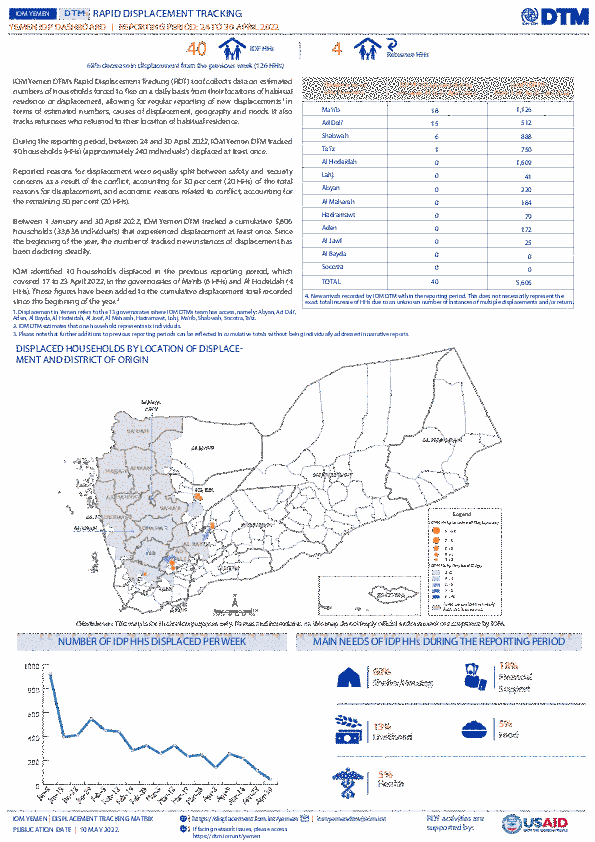
Contact
DTM Yemen, iomyemendtm@iom.int
Language
English
Location
Yemen
Period Covered
Apr 24 2022
May 10 2022
Activity
- Rapid Emergency Registration
- Mobility Tracking
IOM Yemen DTM’s Rapid Displacement Tracking (RDT) tool collects data on estimated numbers of households forced to flee on a daily basis from their locations of origin or displacement, allowing for regular reporting of new displacements in terms of estimated numbers, geography, and needs. It also tracks returnees who returned to their location of origin.
From 1 January to 30 April 2022, IOM Yemen DTM tracked 5,606 households (HH) (33,636 Individuals) who experienced displacement at least once.
Between 24 and 30 April 2022, IOM Yemen DTM tracked 40 households (240 individuals) displaced at least once. The majority of people moved into/within the following governorates and districts:
- Marib (18 HHs) – Marib City (14 HHs), Marib (4 HHs) districts. Most displacements in the governorate originated from Ibb and Marib.
- Ad Dali (15 HHs) – Ad Dali (9 HHs), Qatabah (6 HHs) districts. Most displacements in the governorate originated from Taiz and Ad Dali.
- Shabwah (6 HHs) – Bayhan (6 HHs) district. Most displacements in the governorate originated from Al Bayda.
The majority of people moved from the following governorates and districts:
- Ibb (12 HHs) – Hobeish (3 HHs), Al Odayn (2 HHs), Al Qafr (2 HHs) districts.
- Taiz (6 HHs) – Al Qahirah (2 HHs), Mawiyah (2 HHs), Sami (1 HHs) districts.
- Al Bayda (6 HHs) – Nati (5 HHs), Radman (1 HHs) districts.

Contact
DTMMozambique@iom.int
Language
English
Location
Mozambique
Period Covered
Apr 27 2022
May 03 2022
Activity
- Mobility Tracking
- Event Tracking
During the reporting period (27 April to 03 May 2022), a total of 18 movements were recorded - 7 returns (1,276 individuals), 10 arrivals (311 individuals), and 1 departure (32 individuals). The largest return movements were recorded in Muidumbe (1,118 individuals) and Palma (158 individuals). The largest arrival movements were recorded in Nangade (239 individuals), and Ancuabe (67 individuals). The departure was observed in Metuge (32 individuals). Of the total population, 10 per cent of mobile groups were displaced for the first time, and 90 per cent of reported individuals have been displaced more than once prior to this movement.